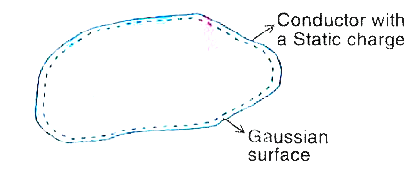In conductors, the outer electrons of each atom or molecule are weakly bound to the atom or molecule. So, these electrons are almost free to move throughout the conductor. Hence, these are called free electrons or conduction electrons. When such a conductor is in an electric field, the free electrons inside redistribute themselves on the surface of the conductor in such a way that the electric field at every point inside the conductor is zero.
Apply Gauss.s law try to prove that any excess static charge given to an insulated conductor resides entirely on its outer surface.
Text Solution
As show in Fig, consider a conductor of any arbitrary shape having a static charge. At an infinitesimal distance from the surface of the conductor construct a Gaussian surface lying inside the conductor. The flux through this Gaussian surface must be zero since E is zero everywhere inside the conductor and on all points on the Gaussian surface. In accordance with Gauss.s law there can be no net charge inside the Gaussian surface.

This shows that all the net charges must be on the surface of the conductor since the Gaussian surface is within an infinitesimal distance of the surface. Thus under static conditions, there can be no net charge inside a conducting body and all the charge must reside on its surface.
The fact that the field inside a conductor is zero holds good for a hollow conductor also. This phenomeno is used in electrostatic shielding to protect electrical instruments.
|
Topper's Solved these Questions
- GAUSS.S LAW BOOK - AAKASH SERIESCHAPTER - GAUSS.S LAW EXERCISE - PROBLEMS (LEVEL - I)
7 Videos
- GAUSS.S LAW BOOK - AAKASH SERIESCHAPTER - GAUSS.S LAW EXERCISE - PROBLEMS (LEVEL - II)
12 Videos
- GAUSS.S LAW BOOK - AAKASH SERIESCHAPTER - GAUSS.S LAW EXERCISE - EXERCISE (LONG ANSWER QUESTIONS)
1 Videos
- FRICTION BOOK - AAKASH SERIESCHAPTER - FRICTION EXERCISE - ADDITIONAL PRACTICE EXERCISE PRACTICE SHEET (ADVANCED) (MORE THAN ONE CORRECT ANSWER TYPE QUESTIONS)
1 Videos
- GRAVITATIONBOOK - AAKASH SERIESCHAPTER - GRAVITATIONEXERCISE - ADDITIONAL PRACTICE EXERCISE (LEVEL-II) PRACTICE SHEET (ADVANCED)Integer Type Questions
6 Videos
Similar Questions
Knowledge Check
Mobility of free electrons in a conductor is
ADirectly proportional to electron densityBDirectly proportional to relaxation timeCInversely proportional to electron densityDInversely proportional to relaxation timeThe average velocity of electrons in a conductor in the absence of electric field is
A102m/sB10−2m/sC104 m/sD10−4 m/sThe average velocity of electrons in a conductor in the absence of electric field is
A10−3m/sB3×108m/sC105m/sDZero
A conductor is at T kelvin. Find the thermal speed of free electrons of the conductor .
View SolutionA conductor is at T kelvin. Find the thermal speed of free electrons of the conductor .
View SolutionA conductor is at T kelvin. Find the thermal speed of free electrons of the conductor .
View SolutionWhat are the possible paths of free electrons inside the conductor ?
View SolutionGood conductors have excess of free electrons. ____________
View Solution
